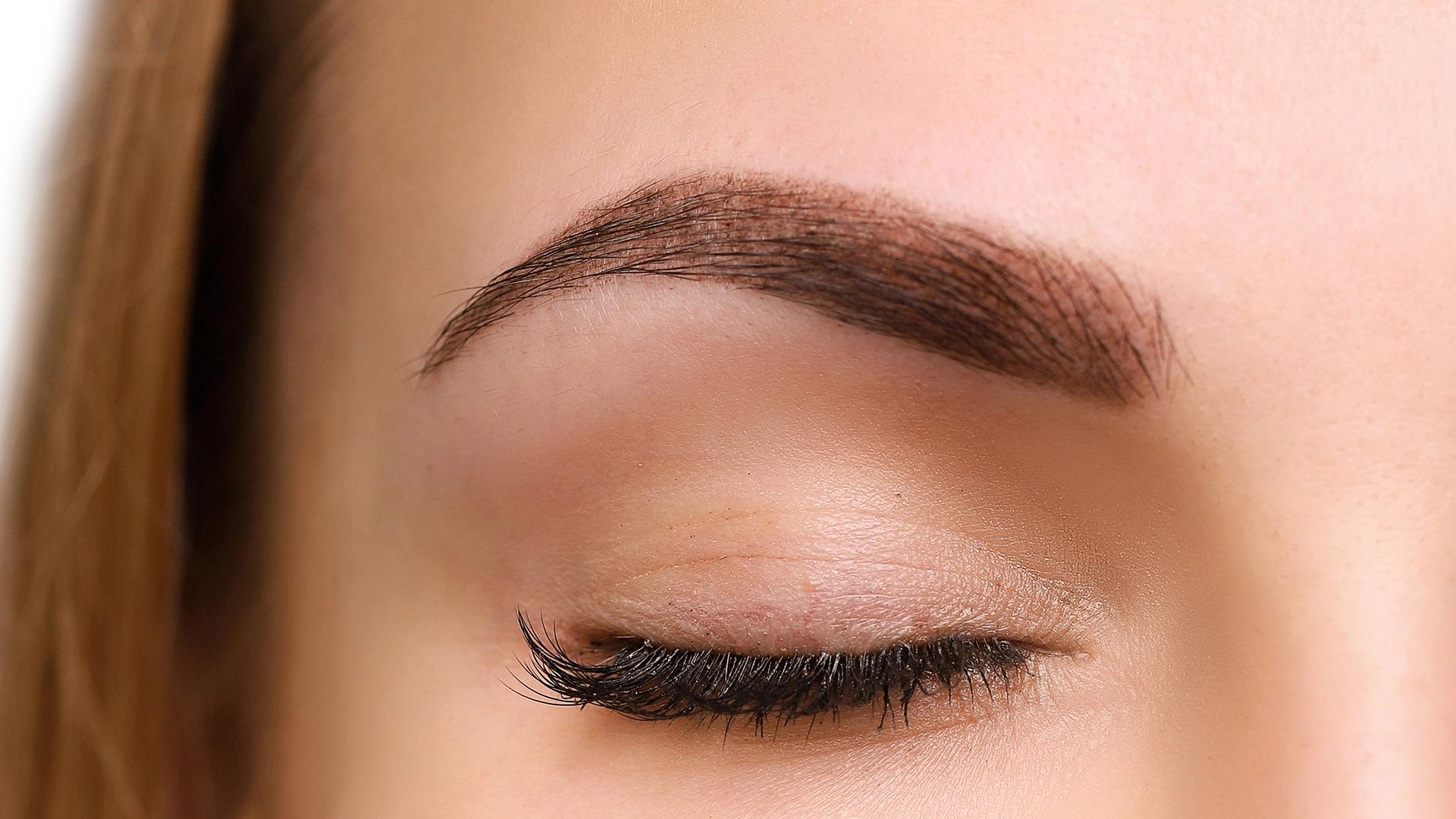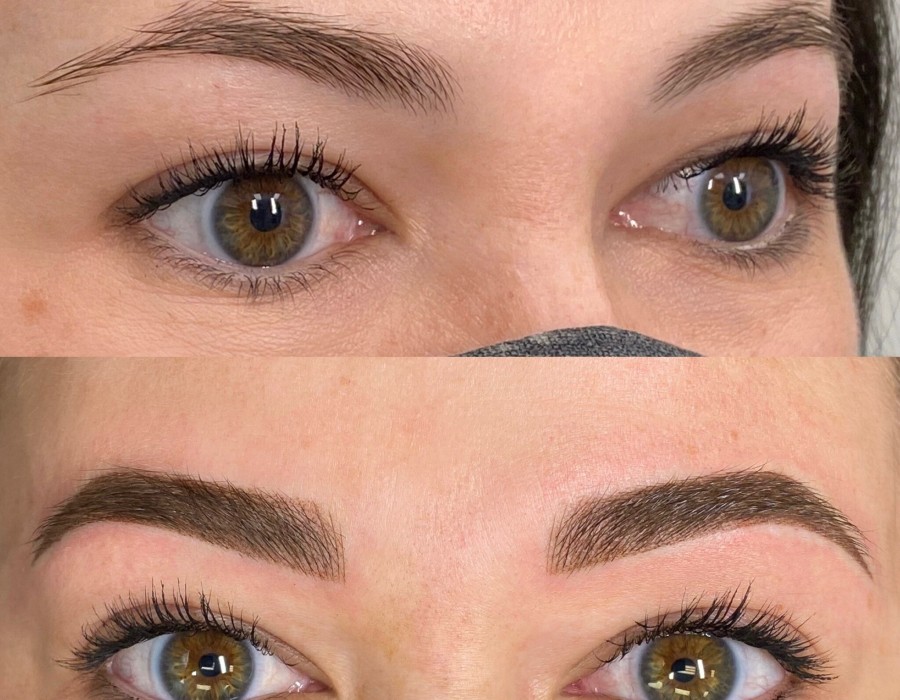Powder brows and microblading are both semi-permanent eyebrow tattooing techniques, but they differ significantly in their application methods, results, and ideal candidates. Both methods aim to enhance the appearance of eyebrows, but each technique provides a unique finish that appeals to different preferences and skin types. Understanding the key differences can help you make an informed decision about which technique is best for you.
In this article, we’ll provide an in-depth comparison of powder brows and microblading, helping you understand the main distinctions, ideal candidates, pros, and cons of each option. We’ll also cover common questions and provide valuable tips to help guide your decision-making process.

What Are Powder Brows?
Powder brows are a semi-permanent eyebrow tattoo technique that uses a cosmetic machine to create a soft, powdery effect, similar to the look of filled-in makeup. The pigment is applied in tiny, pixelated dots, resulting in a soft, shaded effect that mimics the look of powder or makeup. This technique is suitable for a variety of skin types, including oily and mature skin.
The machine used for powder brows deposits pigment deeper into the skin compared to microblading, which allows for longer-lasting results. The final result is typically more defined and fuller compared to the natural-looking hair strokes created with microblading. Powder brows are an excellent choice for those looking for a more bold and filled-in appearance.
What Is Microblading?
Microblading is a semi-permanent eyebrow technique that involves using a manual hand tool with a small blade to deposit pigment under the skin in hair-like strokes. This method creates a very natural and precise look by mimicking the appearance of individual eyebrow hairs. Microblading is best suited for individuals with normal to dry skin types and works well for people who want a more natural look rather than the bold, makeup-like effect achieved with powder brows.
The technique is ideal for those with sparse or thin eyebrows, as it allows the technician to create strokes that blend seamlessly with natural hair. While the final result is realistic, the pigment used in microblading is deposited more superficially in the skin, meaning the results tend to fade faster than powder brows.
Comparison Table: Powder Brows vs Microblading
Feature
Powder Brows
Microblading
Application Tool
Machine with single-needle cartridge
Manual handheld blade
Pigment Technique
Shading using pixelated dots
Fine hair-like strokes
Ideal For
Oily/aging/sensitive skin
Normal to dry skin
Longevity
2 to 3 years
1 to 2 years
Healing Time
7 to 10 days
7 to 14 days
Look
Soft, filled-in, makeup-like
Natural, hair-stroke effect
Pain Level
Mild to moderate pain
Moderate pain
Touch-ups
Every 1 to 2 years
Every 6 to 12 months
Best For
Fuller, bold brows with a makeup effect
Clients wanting natural, sparse brow look
Technical Specs: Powder Brows vs Microblading
Specification
Powder Brows
Microblading
Tool Used
Digital machine
Manual blade
Pigment Deposit
Layered shading effect
Fine, hair-like strokes
Pigment Durability
Longer-lasting (2-3 years)
Shorter-lasting (1-2 years)
Skin Type Suitability
Oily, sensitive, mature skin
Dry to normal skin
Application Time
2 to 3 hours
1 to 2 hours
Final Look
Soft, powdery brows
Natural, feathered hair strokes
Factors to Consider Before Choosing Between Powder Brows and Microblading
When deciding between powder brows and microblading, it’s important to consider various factors, including your skin type, desired eyebrow appearance, pain tolerance, and maintenance expectations.
1. Skin Type
One of the key factors that influence which technique is best for you is your skin type. Powder brows tend to work better for oily, sensitive, or mature skin types. The machine used in powder brows deposits pigment deeper into the skin, which helps the color last longer on oilier or more sensitive skin.
Microblading, on the other hand, is better suited for individuals with normal to dry skin. Since the pigment is deposited more superficially in the skin, it tends to fade faster on oily skin. Additionally, individuals with oily skin may find that the results of microblading are less crisp and may need more frequent touch-ups.
2. Desired Look
If you prefer a natural, hair-like appearance, microblading might be the better option for you. The fine strokes mimic natural eyebrow hairs, creating a soft, realistic look. This technique is best for individuals who want to enhance their existing brows without making them look too filled in or bold.
For those who prefer a fuller, more defined eyebrow with a makeup-like finish, powder brows are the better choice. The shading technique provides a soft, powdery effect that looks like wearing makeup, making it ideal for people who want their brows to look bold and defined without the need for daily makeup application.
3. Pain Tolerance
Both powder brows and microblading involve some level of discomfort, but the pain level can vary depending on individual sensitivity and the method used. Microblading generally causes more discomfort since the blade is manually pressed into the skin. While a numbing cream is applied to minimize pain, some people may still find the procedure uncomfortable.
Powder brows tend to be less painful since the machine uses a single needle to deposit pigment into the skin. The sensation is often described as mild to moderate discomfort, depending on the individual.
4. Maintenance and Longevity
Microblading typically requires touch-ups every 6 to 12 months, depending on how well your skin retains the pigment. Since the pigment is deposited more superficially, it tends to fade faster, especially on oily skin.
Powder brows have a longer lifespan, lasting up to 2 to 3 years before a touch-up is required. The deeper pigment deposit helps powder brows maintain their vibrancy for longer, making them ideal for those who want less frequent touch-ups.

Common Questions About Powder Brows and Microblading
1. Do powder brows hurt more than microblading?
While both procedures cause some discomfort, powder brows generally hurt less than microblading. The technique involves a machine with a single needle, whereas microblading uses a manual blade that can feel more intense. However, both techniques apply a numbing cream to minimize pain.
2. Can I get powder brows if I have oily skin?
Yes, powder brows are ideal for oily or sensitive skin. The technique deposits pigment deeper into the skin, which helps the color stay vibrant longer on oily skin. Microblading may not be as effective on oily skin since the pigment fades more quickly.
3. How long does it take for powder brows to heal?
Powder brows typically take 7 to 10 days to heal. During this time, it’s important to follow aftercare instructions to ensure proper healing and avoid complications. The full results will be visible after about 4 to 6 weeks, as the pigment settles into the skin.
4. Can I switch from microblading to powder brows?
Yes, you can switch from microblading to powder brows. If you’ve previously had microblading and want to try powder brows, it’s important to consult with a skilled technician who can assess your skin and help you achieve the desired results.
Make the Right Decision
Both powder brows and microblading offer unique benefits, depending on your preferences and needs. If you prefer a natural, hair-like appearance and have normal to dry skin, microblading may be the best option. On the other hand, if you want a bold, filled-in look with long-lasting results and have oily or sensitive skin, powder brows may be the better choice.
Ultimately, the decision comes down to your aesthetic preferences, skin type, and willingness to commit to aftercare and touch-up sessions. Consult with a professional eyebrow technician to determine which technique is right for you and enjoy beautifully enhanced brows that will save you time each day.
FAQs: Understanding the Key Differences Between Powder Brows and Microblading
1. Which lasts longer: powder brows or microblading?
Powder brows typically last 2 to 3 years, while microblading lasts about 1 to 2 years. Powder brows tend to retain pigment longer due to deeper placement in the skin.
2. Do powder brows look more natural than microblading?
Not necessarily. Microblading mimics individual hair strokes and appears more natural, while powder brows offer a soft, filled-in look similar to makeup.
3. Which method is better for oily or mature skin?
Powder brows are more suitable for oily, sensitive, or aging skin types. Microblading may fade faster or appear blurry on oily skin.
4. Is there a difference in pain levels between the two techniques?
Yes. Microblading uses a manual blade and can be more painful. Powder brows use a digital machine, which many clients find more comfortable.
5. Can I combine both techniques?
Yes. Combo brows blend microblading’s natural strokes with powder shading’s fullness, offering the best of both styles.





Comments